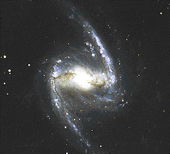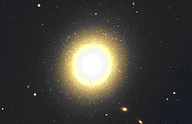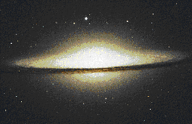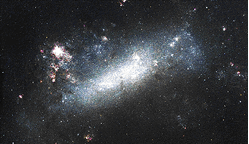Classification
The classification of galaxies due to Hubble (1925) remains the most popular in use today. There are two main categories, the spiral and elliptical galaxies, but also lenticulars and irregulars.


M100, left, and NGC1365, right (AAO)
Spirals
This category includes our own galaxy. They fall into several classes depending on their shape and the relative size of the bulge: ordinary spirals are labelled either Sa, b, c, d or m while those which have developed a bar in the interior region of the spiral arms are SBa, b, c, d or m. Spiral galaxies are characterized by the presence of gas in the disk which means star formation remains active at the present time, hence the younger population of stars. Spirals are usually found in the low density galactic field where their delicate shape can avoid disruption by tidal forces from neighbouring galaxies.

The giant elliptical galaxy M87 (AAO)
Ellipticals
These are placed in the categories E0-7 depending on their degree of ellipticity, with E0 being least elliptical. They have a uniform luminosity and are similar to the bulge in a spiral galaxy, but with no disk. The stars are old and there is no gas present. Ellipticals are usually found in the high density field, at the centre of clusters.

Sombrero galaxy NGC4549 (AAO)
Lenticulars
Lenticulars are labelled S0 and, although they possess both a bulge and a disk, they have no spiral arms. There is little or no gas and so all the stars are old. They appear to be an intermediate.

The Large Magellenic Cloud (AAO)
Irregulars
These are small galaxies, labelled Irr, with no bulge and an ill-defined shape. The Magellenic clouds are examples.
Galaxies are attracted together by gravitation, and so form clusters and other large scale structures across the Universe. Click here to find out more about galaxy clusters and large-scale structures.
